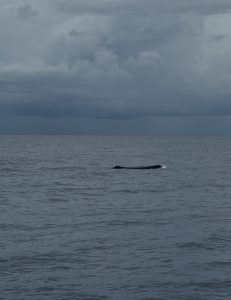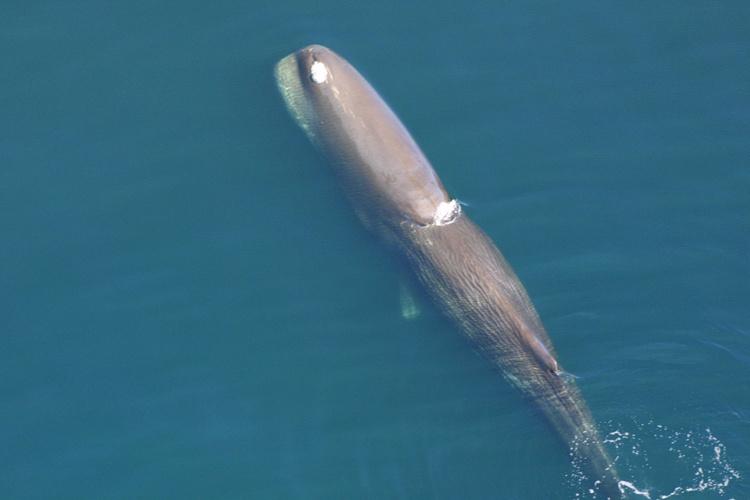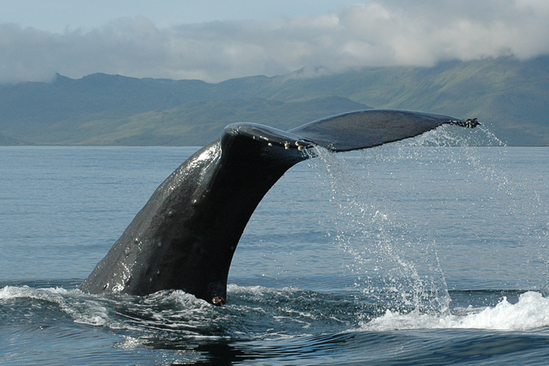We were crossing back to Florida from the Bahamas on our final trip of the 2025 Field Season and it started with a flash of white on the horizon—far off, just barely visible from the bridge. I squinted into the distance, wondering if it was splashing. Maybe a jumping fish? A dolphin? Something was definitely out there. I grabbed the binoculars and focused in. That’s when I saw it clearly: the tall, bushy white blow of a whale taking a breath.
“A whale!” I said, and the captain smiled. “Well, go tell everyone inside!”
I rushed down to let the team know.
“Sperm whale? Pilot whales?” we asked each other, already tossing out guesses as we headed back up to take a closer look.
We slowed the boat and approached cautiously, maintaining a respectful distance. As we got closer, the shapes began to emerge: several broad, wrinkled backs breaking the surface. A spread-out pod of sperm whales (Physeter macrocephalus)—mothers and calves, resting, socializing, and feeding in the deep blue waters of the Atlantic.
At one point, we saw a young whale surface with what looked like a piece of squid in its mouth—confirmation that they were foraging. These incredible animals are deep-diving specialists, and squid make up the bulk of their diet. They’ll dive thousands of feet below the surface for over an hour in search of large squid, including the elusive giant squid.
We turned off the boat engineers and lowered a hydrophone to listen for clicks—sperm whales are known for their loud, rapid click trains used for echolocation and communication—but didn’t hear much this time. Likely, most of the pod was diving or resting silently at the surface. Still, just watching them was enough.
Sperm whales can dive to depths of over 3,000 feet and stay submerged for up to 90 minutes. Down in the darkness, they use powerful clicks to locate prey, mostly squid, and are thought to hunt using a combination of sonar and stealth.

Sperm whale taken from our R/V Stenella on Trip 6.
Sperm Whale Basics: Life Beneath the Surface
Sperm whales are the largest toothed whales on Earth, with adult males reaching lengths of over 50 feet and weighing up to 45 tons. Females are smaller—typically around 36 feet—and live in tight-knit matrilineal groups with their offspring. Males, once they mature, tend to roam more widely and often travel alone or in small bachelor groups.
What makes sperm whales truly unique is their adaptation to the deep. With massive, block-shaped heads—making up about a third of their body length—they house the largest brain of any animal on the planet.
Sperm whales get their name from a waxy substance called spermaceti that’s actually found inside their massive heads. This oily material sits in a large sac and is thought to help the whales focus sound, which is key for echolocation during deep dives.

Sperm whale at water’s surface. Credit: NOAA Fisheries
Back in the day, spermaceti was highly sought after and used in things like oil lamps, candles, and machinery lubricants. Because of this, sperm whales became one of the main targets of commercial whaling, especially from the 1800s through the 1980s. The industry pushed their populations to the brink.
Although large-scale whaling has stopped, sperm whale numbers are still recovering. Today, they’re listed as endangered under the Endangered Species Act and considered depleted under the Marine Mammal Protection Act.
A Family Affair
During our encounter, we observed what appeared to be a nursery group—a mix of adult females and their calves and some juveniles. These kinds of social groups are typical for sperm whales. The mothers often cooperate in raising and protecting their young, with “babysitting” duties shared among the pod.
These pods have strong social bonds, often communicating with a repertoire of codas—click patterns that are thought to be unique to specific clans or family groups. Sperm whales have been observed showing cultural behaviors, passing down knowledge and dialects through generations.
We stayed with the whales for a while, watching quietly as they surfaced and dove in rhythm. There were no breaches, no dramatic displays—but seeing sperm whales in the wild—especially with mothers and calves present—is always a privilege.

Sperm whale global range. Photo credit: NOAA

A sperm whale dives. Credit: NOAA Alaska Fisheries Science Center/Brenda Rone.
What a way to wrap it all up!
